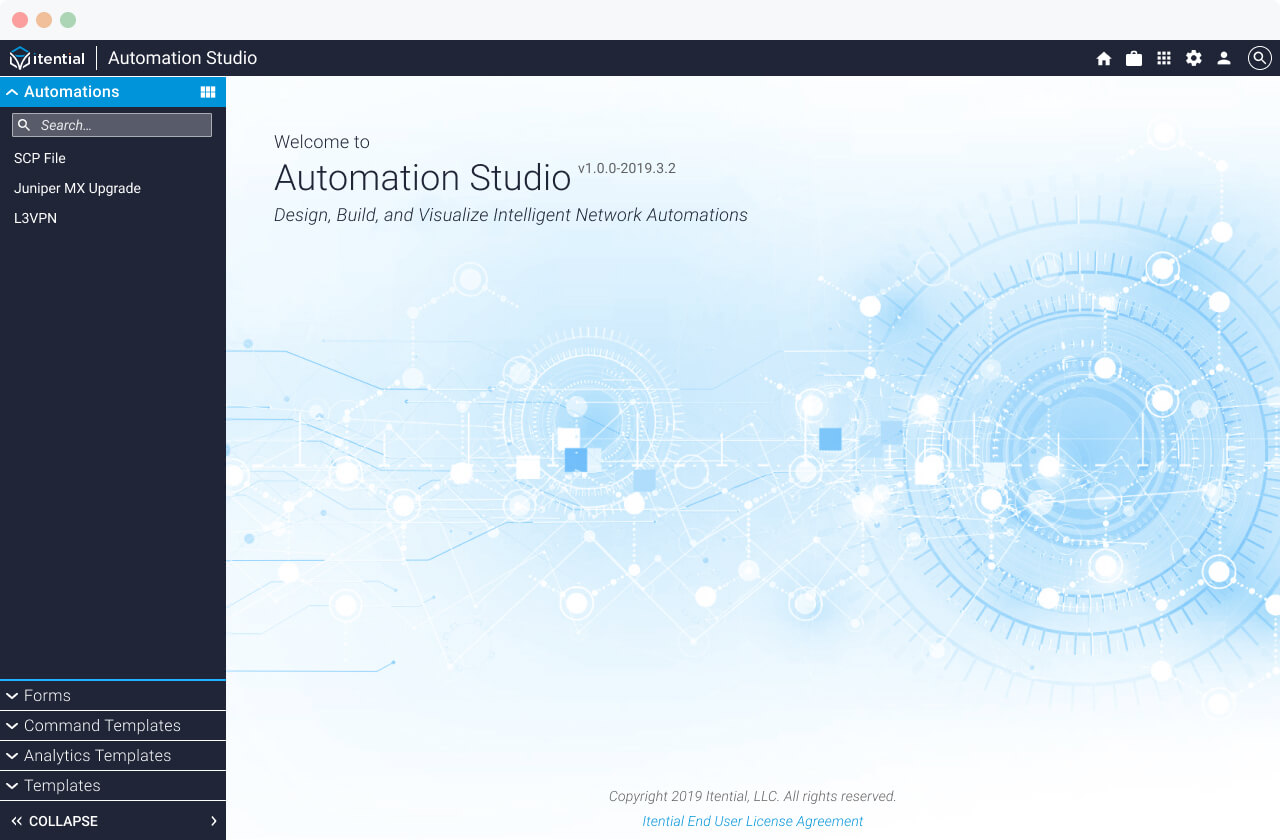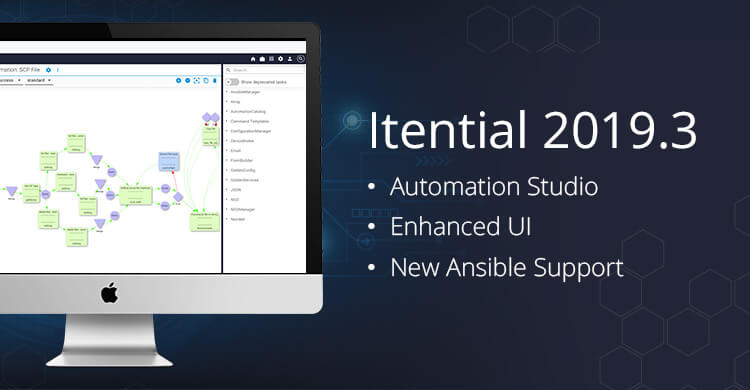At Itential, we are committed to enabling automation for all and we couldn’t be more excited to debut Automation Studio, a key component of our latest 2019.3 product release.
As the newest addition to Itential’s Automation Platform (IAP), Automation Studio makes it even easier to design, build and visualize end-to-end network automations, further expanding participation and accelerating automation activities.
Let’s take a deep dive into our latest 2019.3 product release including Automation Studio and additional features.
Automation Studio

The purpose of this application is to take the first step in unifying the experience of creating automations. You will see there are a number of our tools that have been consolidated in the framework of this app. The secondary goal of this application is to maintain the same user experience with previous versions for the underlying pages such as automation builder, form builder, command templates, and template builder but pull them under one umbrella application that makes the transition seamless.
The main features for this new application include the following:
- Unification – By unifying a few of our platform components into a single application, the user experience feels more ‘under one roof’ than in previous releases. The most common items used to build an automation are grouped and made more readily accessible in a single window.
- Ease of Use – In addition to the unification effort, various small user experience items were added to accommodate the new look and empower developers and software engineers of all expertise can participate in network automations. These includes the placement of tasks, the organization of form builder, and standardization of button bars throughout automation building tools. All of these changes combined with the Automation Studio framework help our new users get up to speed more quickly with creating their own automations without having to write code.
- User Separation of Duties – We’ve received feedback from our user community that the previous release did not provide clear delineation of duties between “creating automations as a designer” and “running automations as an operator.” With Automation Studio, this application targets the automation designer and begins to tell the story of the automation operator and the designer as two distinct and necessarily different types of users.
- Jinja2 Support for Templates – Previously, Template Builder only functioned with textFSM templates, but with the release of Automation Studio it has been enhanced to render Jinja2 templates as well. Additionally, an automation task has been added to render Jinja2 templates from within automations.
- Consolidate Datatype Manipulation Actions – Previously, within the Automation Builder task picker, these actions were divided into many different spaces which could cause confusion for automation designers, additional maintenance for application management, and code maintenance overhead. Also, due to the nature of the implementation, task names could be duplicated further confusing the designers. These datatype manipulation actions have been consolidated into one place, cleaned from unnecessary code, and deduplicated across all data types.
- Move Data Transformation Items to Task Dialog – In order to reduce the complexity and busyness of automations, the datatype manipulation actions have been moved to each task’s dialog as opposed to separate individual tasks. Further, these actions can be ‘chained’ to run in sequential order providing the automation designer maximum usability and flexibility with an intuitive user interface.
With the addition of the Automation Studio application, the roadmap for modifying the underlying “builder” tools become easier to plan, develop, and ultimately was created for the good of our users. We look forward to the additions ahead to make Automation Studio even better. Stay tuned!
Take a Tour of Automation Studio >
Complete User Interface Overhaul
Welcome to an entirely new navigational experience for IAP! The top navigation has been organized with easy to use buttons and drop-down menus containing the app choices, while the side navigation has reclaimed valuable space for the main page from our previous navigation paradigm. Additionally, the following items outline some very practical improvements this UI refresh affords:
- New ‘Activities Menu’ – Removes Active Tasks, Active Jobs and Job Manager from the ‘apps menu’ for quicker access by users that work automation flows.
- Persistent Access to Content and Features within an Application – Eliminates the need for users to close active content and return to a homepage.
- Search Capability for Content – Enables users to filter navigation menus and find things quickly.
- Collapsible Sidebar Navigation – Allows users to maximize their workspace within applications.
- Standardize Color Scheme/Design Pattern – Updated the color in sidebar to a dark palette, visually minimizing the navigation and distinguishing it from the workspace, which helps users focus on active content and tasks associated with it.
Other 2019.3 Release Features
Configuration Manager
Enhanced Zero-Touch Auto-Remediation
To enhance ‘zero-touch auto-remediation,’ the platform now allows a Golden Configuration author to define how missing lines should be fixed in auto-remediation workflows when the fix would otherwise be ambiguous. When setting up the configuration, the user specifies how Configuration Manager should handle the remediation as opposed to guessing (which is never good when doing remediation tasks).
Golden Configuration Group Based Access Control
Golden Configs can now be setup with group-based access, where those with access to do so can specify which users are allowed to see their golden configs. This feature is useful in implementations that are shared across multiple teams where configuration either needs to be hidden due to security concerns or desire to be hidden for simplicity, ease of use, and organization.
Automation Gateway
Added Support for Ansible 2.8 & 2.9
Support for latest Ansible builds.
Execution UI
Users can now run Ansible Playbooks, Modules, and Roles directly within the Automation Gateway user interface. Previously, this required execution via the built-in OpenAPI documentation or Postman. Enabling users to execute directly within the UI simplifies development and testing and accelerates time to deployment.
Our goal with the latest release of 2019.3 is to expand cross-functional participation through the rapid, low-code environment for easy creation and management of end-to-end automations. All of the additions and updates to IAP are aimed to help you and your NetOps teams achieve your automation goals.
Be sure to register for our upcoming live webinar on Wednesday, February 12th, “Democratizing Network Automation Through Low-Code Automation” to learn how you can utilize Automation Studio to bridge the skills gap, expand participation and accelerate network automation within your organization.

